
In the summer of 1988, scientist James Hansen testified to Congress that carbon dioxide from burning fossil fuels was dangerously warming the planet. Scientific meetings were held, voluminous reports were written, and national pledges were made, but because fossil fuels were comparatively cheap, little concrete action was taken to reduce carbon emissions.
Then, beginning around 2009, first wind turbines and then solar photovoltaic panels decreased enough in cost to become competitive in electricity markets. More installations resulted in more “learning curve” cost reductions—the decrease in cost with every doubling of deployment. Since 2009, the prices of wind and solar power have decreased by an astonishing 72% and 90%, respectively, and they are now the cheapest electricity sources although some challenges still exist.
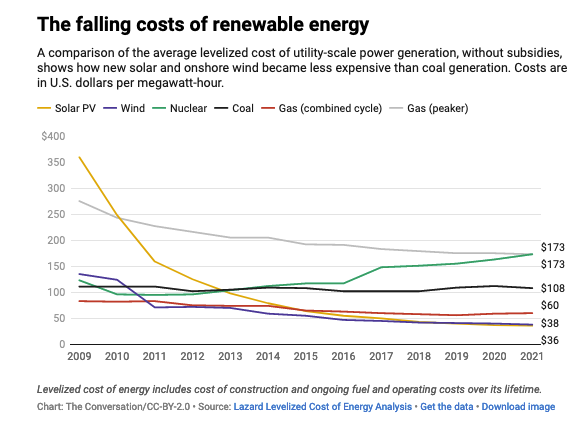
With the planet facing increasingly intense heat waves, drought, wildfires and storms, a path to tackle the climate crisis became clear: Transition the electric grid to carbon-free wind and solar and convert most other fossil fuel users in transportation, buildings, and industry to electricity.
The U.S. is headed in that direction. Early projections suggest the world just wrapped up a record year of renewable electricity growth in 2021, following a record 33,500 megawatts of solar and wind electricity installed in the U.S. in 2020, according to BloombergNEF data. Even faster growth is expected ahead, especially given the Biden administration’s plans to tap high-value offshore wind resources. But will it be fast enough?
The Biden administration’s goal is to have a carbon-emissions-free grid by 2035. One recent study found that the U.S. will need to nearly triple its 2020 growth rate for the grid to be 80% powered by clean energy by 2030. (As difficult as that may sound, China reportedly installed 120,000 megawatts of wind and solar in 2020.)
The foundation of this transition is a dramatic change in the electric grid itself.
Scaling up wind and solar
Hailed as the greatest invention of the 20th century, our now-aging grid was based on fundamental concepts that made sense at the time it was developed. The original foundation was a combination of “base load” coal plants that operated 24 hours a day and large-scale hydropower.
Beginning in 1958, these were augmented by nuclear power plants, which have operated nearly continuously to pay off their large capital investments. Unlike coal and nuclear, solar and wind are variable; they provide power only when the sun and wind are available.
Converting to a 21st-century grid that is increasingly based on variable resources requires a completely new way of thinking. New sources of flexibility—the ability to keep supply and demand in balance over all time scales—are essential to enable this transition.
There are basically three ways to accommodate the variability of wind and solar energy: use storage, deploy generation in a coordinated fashion across a wide area of the country along with more transmission, and manage electricity demand to better match the supply. These are all sources of flexibility.
Storage is now largely being provided by lithium-ion batteries. Their costs have plummeted, and new storage technologies are being developed.
Expanded transmission is especially valuable. When the Northeast is experiencing peak electric demand in the early evening, there is still sun in the West. And, with more transmission, the large wind resources in the center of the country can send electricity toward both coasts. Transmission studies have shown that stronger interconnections among the country’s three power grids are highly beneficial.
Making buildings more efficient and controlling their demand can also play a big role in cleaning up the grid. Buildings use 74% of U.S. electricity. Interconnected devices and equipment with smart meters can reduce and reshape a building’s power use.
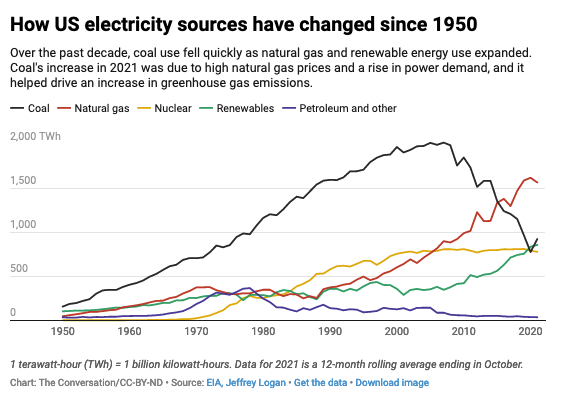
Innovations that make 100% clean power possible
Many analysts believe the U.S. can cost-effectively and reliably operate a power grid with 80% to 90% clean electricity, but decarbonizing the last 10% to 20% will be notably more challenging. While short-duration storage, lasting four hours or less, is becoming ubiquitous, we will likely need to provide power during some periods when wind and solar resources are at low levels (what the Germans call dunkelflaute, or “dark doldrums”). An expanded national transmission network will help, but some amount of long-duration storage will likely be needed.
Numerous options are being explored, including alternative battery technologies and green hydrogen.
Flow batteries are among the promising approaches that we are working on at the Renewable and Sustainable Energy Institute at the University of Colorado. In a typical design, liquid electrolyte flows between two storage tanks separated by a membrane. The tanks can be scaled up in size corresponding to the desired storage duration.
Green hydrogen is a potential storage option for very long durations. It is produced by splitting water molecules with an electrolyzer powered by renewable electricity. The hydrogen can be stored underground (or in above-ground tanks) and either burned in combustion turbines or converted back to electricity in fuel cells. Green hydrogen is currently very expensive but is expected to become more affordable as the cost of electrolyzers decreases.
In addition, new business, market design, and grid operator models are emerging. Community solar gardens, for example, allow homeowners to purchase locally produced solar electricity even if their own roofs are not suitable for solar panels. Microgrids are another business model becoming common on campuses and complexes that produce electricity locally and can continue to operate if the grid goes down. Clean microgrids are powered by renewable energy and batteries.
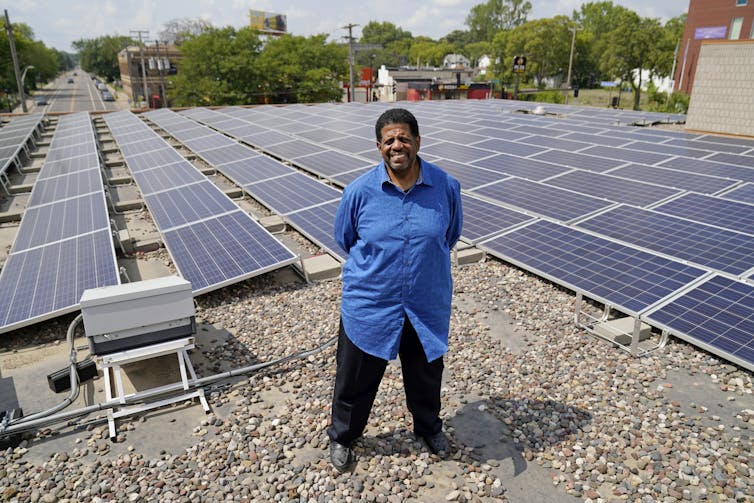
Innovative market designs include time-of-use rates that encourage electricity use, such as for charging electric vehicles, when renewable electricity is plentiful. Expanded balancing area coordination draws on variable solar and wind resources from a wide region to provide a smoother overall supply. Improved grid operations include advanced forecasting of wind and solar to minimize wasted power and reduce the need for costly standby reserves. Dynamic line rating allows grid operators to transmit more electricity through existing lines when favorable weather conditions permit.
Across the economy, greater attention to energy efficiency can enable power sector transformation, minimizing costs, and improving reliability.
Nuclear power is also essentially carbon-free, and keeping existing nuclear plants running can make the transition to renewables easier. However, new nuclear plants in the U.S. are very expensive to build, have long construction times and may prove too costly to operate in a manner that would help firm variable solar and wind.
In our view, the urgency of climate change demands an all-out effort to address it. Having a 2035 emissions goal is important, but the emissions reduction path the U.S. takes to reach that goal is critical. The No. 1 need is to minimize adding carbon dioxide and other greenhouse gases to the atmosphere. The world already has the tools to get the grid 80% to 90% carbon-free, and technical experts are exploring a wide range of promising options for achieving that last 10% to 20%.
Charles F. Kutscher is a fellow and senior research associate at the Renewable & Sustainable Energy Institute, University of Colorado Boulder. Jeffrey Logan is associate director of energy policy and analysis at the Institute. This post originally appeared at The Conversation.
Weekly Newsletter
Get building science and energy efficiency advice, plus special offers, in your inbox.




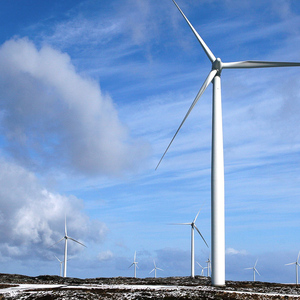

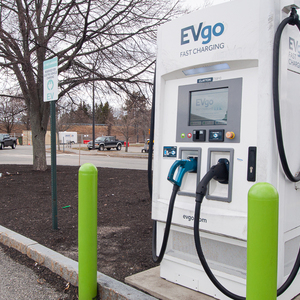
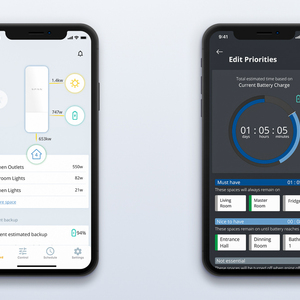






7 Comments
This all sounds terrific but before I disconnect my oil-fired hot water boiler and convert to all electric, the authors will need to provide detail engineering feasibility and certifiable cost analysis for storing wind and solar’s inefficient and intermittent energy production. Are those costs included in “Falling Costs” graph?
They are not. Nor are the amortized capital costs for providing 100% conventional backup generation for the 10% or 20% dunkelflaute power needs. Do the physics of hydrogen make economic sense?
What will rates look like when these costs are included? I have seen some estimates of trillions of dollars to build out battery storage capacity sufficient to overcome renewable’s intermittency. Like 10x the US GDP.
And where will all those rare earths come from?
Additionally, I would like to see what the total system loss looks like for residential electric heating. Gas and oil heat have far less “transmission loss”.
I’m unsure why anyone would use Germany as an energy model for the future. If anything, their post-nuclear experience suggests great difficulty and expense getting to a clear energy future. Texas, too.
Proponents of 100% clean energy need to provide far more comprehensive and detailed engineering feasibility and cost analysis before the average US consumer and homeowner will get on board and support a non-carbon energy world.
I, for one, am unwilling to convert to all electric for my 40 year old home unless I can be reassured of 99.8% uptime and cost equivalence
"I, for one, am unwilling to convert to all electric for my 40 year old home unless I can be reassured of 99.8% uptime and cost equivalence"
That's an extremely low hurdle for most Americans who heat with oil and pay average electricity rates! Nuanced thinking is important for this topic, s0 why 100% backup? Keep the oil boiler for a handful of hours per year and use a heat pump for the rest, easily slashing costs, carbon emissions and placing almost no strain on the grid. If electrification is accomplished optimally, I'd expect electric rates to significantly fall from higher utilization of distribution assets.
A great point, and an excellent personal energy strategy.
But I’m still reliant on electricity, and depending how and how quickly the federal and my state governments mandate this transition, there’s no hiding from it. I still need dependable electrical service for my boiler to run. Rushing toward 100% renewables prematurely without all the solutions detailed is what I’m skeptical of.
I wouldn't worry about rushing - even at solar and wind's blistering installation pace, we are a long way from 100% renewable and I don't expect Federal mandates with teeth will ever happen. For now, renewables = cheaper electricity.
“[Deleted]”
I understand that "nuclear" energy is a dirty word right now. I am a degreed physicist, and worked at a federal nuclear energy research lab. I also took a course in solar engineering in the 80's. And I agree that the current generation of nuclear power plants are horrible. They need highly enriched uranium, have all kinds of crazy back up systems to try to keep them safe, and still, are inherently unstable and fail in spectacular and environmentally devastating fashion.
But there is a new generation of reactor now ready for proof. They are totally fail safe by their very design. If there is any problem, they shut themselves down and cannot explode in any fashion. They run on much lower enriched uranium and may be able to even run on the spent fuel from our current reactors. And they can be manufactured to a much smaller size to run a small community.
I agree that our planets future depends on renewables, but we need a clean source to fill the gap, both in terms of the time frame and power load balancing. I just finished building a new home that is heavily insulated, properly built with respect to the sun, and have a 33 solar PV panel system, all in "sunny" Ohio.
Please take some time to look at these new nuclear plants and spread the word that they are also needed. In particular, I recommend you look at TerraPower. It probably has the best chance of making it a reality.
Even the safest nuclear plants still have long-term radioactive storage issues and take an extremely long time to design and build. Plus PV and wind plus storage costs are continuing to fall, so it's extremely unlikely nuclear will ever be able to compete economically. Nuclear just doesn't make much sense anymore.
Log in or create an account to post a comment.
Sign up Log in